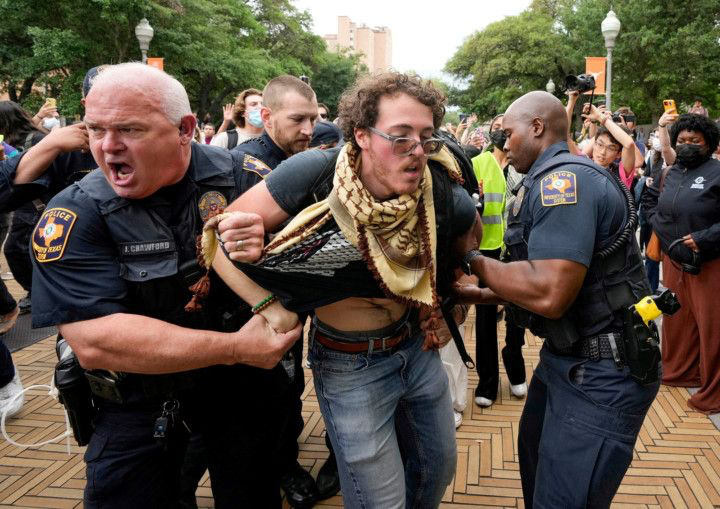[Protesters at George Washington University by Jordan Tovin for The Washington Post]
___________________________________________
“Congress shall make no law respecting…the right of the people peaceably to assemble, and to petition the Government for a redress of grievances”
— U.S. Constitution, First Amendment.
______________________________________________
In a totalitarian society, the policing of dissent is straightforward and predictable — it is the swift use of force and arrest. Training and outfitting this method is not complex. Not so in a free society; a free society, needs well-trained, well-led, and emotionally intelligent police!
As a new police chief In Madison, Wisconsin. in the early 70s, I knew that I had my work cut out for me. In my job interviews, I outlined a style of policing that was oriented toward peacekeeping and managing conflict. I knew deep-down there was a better way to respond to public protest than what most of us were doing.
This measured and dialogical way we developed began to be called “The Madison Method.” Young officer Mike Masterson saw that it worked and when he retired as a Madison captain, he went on to head up police in Boise, ID for a decade. He wrote about the Madison Method he learned in the FBI Bulletin. (Read the article, “Crowd Management: Developing a New Paradigm” HERE.)
The article should be required reading for all police leaders. As Chief Masterson observed, the Madison Method has also been proved effective in the U.K. by Professor Clifford Stott who, with others, researched a better way to police football crowds. It is very similar to the Madison Method which we developed in the ear;u 1970s.
“This current study demonstrates that, where policing is in line with the principles of negotiated management, there are associated and measurable reductions of violence… [O]ur data also suggest that the group-level social psychological processes associated with negotiated management could also function to positively transform previously negative relationships between high risk groups and the police and lead to the psychological marginalization of those who seek violence. This finding suggests that while high profile, coercive, and ultimately militaristic policing (i.e., baton charges, water cannon, tear gas) may well be effective at gaining short term control of a physical location, such a heavy hand could actually function to generate and maintain a negative relationship over the long term between the police and specific communities…”
As protests about police use of deadly force engulfed many cities during the last decade in our nation, The Madison Method was also examined and reported by The Marshall Project; a popular journalism site which covers current issues in criminal justice. [There is also an article on it in Police1]
Now, almost 50 years later, Madison police policy (2024) states, “Officers will utilize seven principles, known as the ‘Madison Method,’ when working with crowds.”
The Madison Method
- We protect community members’ constitutional rights to assemble, to petition the
government, and to engage in free speech. - We are impartial and remain neutral regardless of the issue.
- We maintain open dialogue with community members and the news media before,
during, and after demonstrations. - We monitor demonstrations and marches to protect individual rights and ensure
public safety. - We balance the rights of demonstrators with the rights of the community at large.
- We use restraint in the use of force; we protect people first and property second.
- We, as peace officers, pursue continuous improvement of our method.
In “Arrested Development,” I described three major events in which we successfully used this method. I might also say that in 20 years of policing a diverse city with a large politically active university, we never failed in using this approach. This record speaks loudly for itself in a city known for mass protests regarding politics, student rights, and racism.
Now to the present situation. Today we are seeing protests centered on college campuses regarding the war in Gaza. Earlier this week, Peter Hermann reported in The Washington Post that D.C. police, in contrast to other cities across the nation, were restrained in their use of force to remove students. It sounded like the Madison Method was again in practice — it always begins with restraint and dialogue. He wrote:
“D.C. police rejected pleas from George Washington University officials to clear pro-Palestinian demonstrators out of an on-campus encampment early Friday morning, saying they worried about the optics of moving against a small number of peaceful protesters…
“Officers had assembled around 3 a.m. Friday and were prepared to enter the encampment, but senior leaders in the police chief’s and mayor’s office ordered them to stand down, the officials said. The demonstrators were small in number and largely peaceful, and the city officials told their university counterparts they wanted to avoid images of violent altercations between police and protesters flashing on TV screens across the country. The George Washington campus [is] in downtown Washington, five blocks from the White House.”
In other cities, at least 900 protesters have been arrested at these demonstrations on college campuses. It has been the largest police response to campus activism in recent years. And, again, police are confronted with the challenge posed by citizens demanding their Constitutional right to “peaceably assemble and petition the government.” Read the full article HERE.
It remains to be seen as to how these protests will continue to be handled by police. The one thing that is a prerequisite to putting the Madison Method into practiceis that the method works best (maybe only) when PRIOR to a protest event, the police department has a trusted relationship with the impacted community.
Simply said, this method will most likely NOT work in an environment that categorically mistrusts their police. So, the actual first step to prepare by practicing fair and impartial policing and that every police contact meets the requirements of Procedural Justice. Community trust is essential to effectively police a free and diverse society such as ours.
In the meantime, press on, dialogue, and be restrained!
Democracy is messy, but it beats the alternative.
___________________________
[Note: I will add here a discussion I once had after we successfully responded to a campus protest without making arrests or having property damaged. The protest leader criticized our strategy in using the method. It went like this: “I appreciate what you are trying to do, but you are interfering with the intent of our protest and our rights. Perhaps you don’t understand, when you dialogue and work with us you are taking away the impact and attention on what we are protesting. You see, we need arrests, even property damage, and the resulting attention of the media. It highlights the grievances we are addressing. In effect, you and your officers, have diminished the impact of what we were protesting!”]




